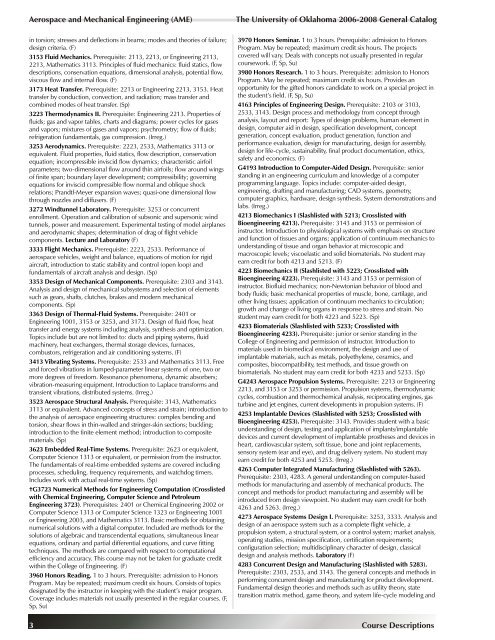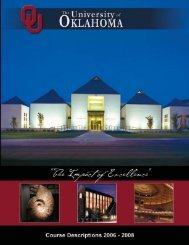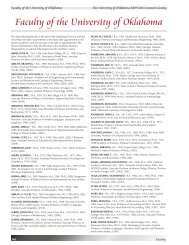Aerospace and Mechanical Engineering (AME)The Uni ver sity <strong>of</strong> <strong>Oklahoma</strong> <strong>2006</strong>-20<strong>08</strong> Gen eral Cat a login torsion; stresses and deflections in beams; modes and theories <strong>of</strong> failure;design criteria. (F)3153 Fluid Mechanics. Prerequisite: 2113, 2213, or Engineering 2113,2213, Mathematics 3113. Principles <strong>of</strong> fluid mechanics: fluid statics, flowdescriptions, conservation equations, dimensional analysis, potential flow,viscous flow and internal flow. (F)3173 Heat Transfer. Prerequisite: 2213 or Engineering 2213, 3153. Heattransfer by conduction, convection, and radiation; mass transfer andcombined modes <strong>of</strong> heat transfer. (Sp)3223 Thermodynamics II. Prerequisite: Engineering 2213. Properties <strong>of</strong>fluids; gas and vapor tables, charts and diagrams; power cycles for gasesand vapors; mixtures <strong>of</strong> gases and vapors; psychrometry; flow <strong>of</strong> fluids;refrigeration fundamentals, gas compression. (Irreg.)3253 Aerodynamics. Prerequisite: 2223, 2533, Mathematics 3113 orequivalent. Fluid properties, fluid statics, flow description, conservationequation; incompressible inviscid flow dynamics; characteristic airfoilparameters; two-dimensional flow around thin airfoils; flow around wings<strong>of</strong> finite span; boundary layer development; compressibility; governingequations for inviscid compressible flow normal and oblique shockrelations; Prandtl-Meyer expansion waves; quasi-one dimensional flowthrough nozzles and diffusers. (F)3272 Windtunnel Laboratory. Prerequisite: 3253 or concurrentenrollment. Operation and calibration <strong>of</strong> subsonic and supersonic windtunnels, power and measurement. Experimental testing <strong>of</strong> model airplanesand aerodynamic shapes; determination <strong>of</strong> drag <strong>of</strong> flight vehiclecomponents. Lecture and Laboratory (F)3333 Flight Mechanics. Prerequisite: 2223, 2533. Performance <strong>of</strong>aerospace vehicles, weight and balance, equations <strong>of</strong> motion for rigidaircraft, introduction to static stability and control (open loop) andfundamentals <strong>of</strong> aircraft analysis and design. (Sp)3353 Design <strong>of</strong> Mechanical Components. Prerequisite: 2303 and 3143.Analysis and design <strong>of</strong> mechanical subsystems and selection <strong>of</strong> elementssuch as gears, shafts, clutches, brakes and modern mechanicalcomponents. (Sp)3363 Design <strong>of</strong> Thermal-Fluid Systems. Prerequisite: 2401 orEngineering 1001, 3153 or 3253, and 3173. Design <strong>of</strong> fluid flow, heattransfer and energy systems including analysis, synthesis and optimization.Topics include but are not limited to: ducts and piping systems, fluidmachinery, heat exchangers, thermal storage devices, furnaces,combustors, refrigeration and air conditioning systems. (F)3413 Vibrating Systems. Prerequisite: 2533 and Mathematics 3113. Freeand forced vibrations in lumped-parameter linear systems <strong>of</strong> one, two ormore degrees <strong>of</strong> freedom. Resonance phenomena, dynamic absorbers;vibration-measuring equipment. Introduction to Laplace transforms andtransient vibrations, distributed systems. (Irreg.)3523 Aerospace Structural Analysis. Prerequisite: 3143, Mathematics3113 or equivalent. Advanced concepts <strong>of</strong> stress and strain; introduction tothe analysis <strong>of</strong> aerospace engineering structures: complex bending andtorsion, shear flows in thin-walled and stringer-skin sections; buckling;introduction to the finite element method; introduction to compositematerials. (Sp)3623 Embedded Real-Time Systems. Prerequisite: 2623 or equivalent,Computer Science 1313 or equivalent, or permission from the instructor.The fundamentals <strong>of</strong> real-time embedded systems are covered includingprocesses, scheduling, frequency requirements, and watchdog timers.Includes work with actual real-time systems. (Sp)†G3723 Numerical Methods for Engineering Computation (Crosslistedwith Chemical Engineering, Computer Science and PetroleumEngineering 3723). Prerequisites: 2401 or Chemical Engineering 2002 orComputer Science 1313 or Computer Science 1323 or Engineering 1001or Engineering 2003, and Mathematics 3113. Basic methods for obtainingnumerical solutions with a digital computer. Included are methods for thesolutions <strong>of</strong> algebraic and transcendental equations, simultaneous linearequations, ordinary and partial differential equations, and curve fittingtechniques. The methods are compared with respect to computationalefficiency and accuracy. This course may not be taken for graduate creditwithin the College <strong>of</strong> Engineering. (F)3960 Honors Reading. 1 to 3 hours. Prerequisite: admission to HonorsProgram. May be repeated; maximum credit six hours. Consists <strong>of</strong> topicsdesignated by the instructor in keeping with the student’s major program.Coverage includes materials not usually presented in the regular courses. (F,Sp, Su)3970 Honors Seminar. 1 to 3 hours. Prerequisite: admission to HonorsProgram. May be repeated; maximum credit six hours. The projectscovered will vary. Deals with concepts not usually presented in regularcoursework. (F, Sp, Su)3980 Honors Research. 1 to 3 hours. Prerequisite: admission to HonorsProgram. May be repeated; maximum credit six hours. Provides anopportunity for the gifted honors candidate to work on a special project inthe student’s field. (F, Sp, Su)4163 Principles <strong>of</strong> Engineering Design. Prerequisite: 2103 or 3103,2533, 3143. Design process and methodology from concept throughanalysis, layout and report: Types <strong>of</strong> design problems, human element indesign, computer aid in design, specification development, conceptgeneration, concept evaluation, product generation, function andperformance evaluation, design for manufacturing, design for assembly,design for life-cycle, sustainability, final product documentation, ethics,safety and economics. (F)G4193 Introduction to Computer-Aided Design. Prerequisite: seniorstanding in an engineering curriculum and knowledge <strong>of</strong> a computerprogramming language. Topics include: computer-aided design,engineering, drafting and manufacturing; CAD systems, geometry,computer graphics, hardware, design synthesis. System demonstrations andlabs. (Irreg.)4213 Biomechanics I (Slashlisted with 5213; Crosslisted withBioengineering 4213). Prerequisite: 3143 and 3153 or permission <strong>of</strong>instructor. Introduction to physiological systems with emphasis on structureand function <strong>of</strong> tissues and organs; application <strong>of</strong> continuum mechanics tounderstanding <strong>of</strong> tissue and organ behavior at microscopic andmacroscopic levels; viscoelastic and solid biomaterials. No student mayearn credit for both 4213 and 5213. (F)4223 Biomechanics II (Slashlisted with 5223; Crosslisted withBioengineering 4223). Prerequisite: 3143 and 3153 or permission <strong>of</strong>instructor. Bi<strong>of</strong>luid mechanics; non-Newtonian behavior <strong>of</strong> blood andbody fluids; basic mechanical properties <strong>of</strong> muscle, bone, cartilage, andother living tissues; application <strong>of</strong> continuum mechanics to circulation;growth and change <strong>of</strong> living organs in response to stress and strain. Nostudent may earn credit for both 4223 and 5223. (Sp)4233 Biomaterials (Slashlisted with 5233; Crosslisted withBioengineering 4233). Prerequisite: junior or senior standing in theCollege <strong>of</strong> Engineering and permission <strong>of</strong> instructor. Introduction tomaterials used in biomedical environment, the design and use <strong>of</strong>implantable materials, such as metals, polyethylene, ceramics, andcomposites, biocompatibility, test methods, and tissue growth onbiomaterials. No student may earn credit for both 4233 and 5233. (Sp)G4243 Aerospace Propulsion Systems. Prerequisite: 2213 or Engineering2213, and 3153 or 3253 or permission. Propulsion systems, thermodynamiccycles, combustion and thermochemical analysis, reciprocating engines, gasturbine and jet engines, current developments in propulsion systems. (F)4253 Implantable Devices (Slashlisted with 5253; Crosslisted withBioengineering 4253). Prerequisite: 3143. Provides student with a basicunderstanding <strong>of</strong> design, testing and application <strong>of</strong> implants/implantabledevices and current development <strong>of</strong> implantable prostheses and devices inheart, cardiovascular system, s<strong>of</strong>t tissue, bone and joint replacements,sensory system (ear and eye), and drug delivery system. No student mayearn credit for both 4253 and 5253. (Irreg.)4263 Computer Integrated Manufacturing (Slashlisted with 5263).Prerequisite: 2303, 4283. A general understanding on computer-basedmethods for manufacturing and assembly <strong>of</strong> mechanical products. Theconcept and methods for product manufacturing and assembly will beintroduced from design viewpoint. No student may earn credit for both4263 and 5263. (Irreg.)4273 Aerospace Systems Design I. Prerequisite: 3253, 3333. Analysis anddesign <strong>of</strong> an aerospace system such as a complete flight vehicle, apropulsion system, a structural system, or a control system; market analysis,operating studies, mission specification, certification requirements;configuration selection; multidisciplinary character <strong>of</strong> design, classicaldesign and analysis methods. Laboratory (F)4283 Concurrent Design and Manufacturing (Slashlisted with 5283).Prerequisite: 2303, 2533, and 3143. The general concepts and methods inperforming concurrent design and manufacturing for product development.Fundamental design theories and methods such as utility theory, statetransition matrix method, game theory, and system life-cycle modeling and3 <strong>Course</strong> <strong>Descriptions</strong>
The Uni ver sity <strong>of</strong> <strong>Oklahoma</strong> <strong>2006</strong>-20<strong>08</strong> Gen eral Cat a logAerospace and Mechanical Engineering (AME)optimization will be introduced. No student may earn credit for both 4283and 5283. (F)G4362 Experimental Stress Analysis (Crosslisted with Civil Engineering4362). Prerequisite: Engineering 2153; AME 3112 or equivalent orgraduate standing. Determination <strong>of</strong> stress by means <strong>of</strong> bonded wire, metalfilm and semiconductor strain gages, brittle coating and photoelasticity.Design, selection and use <strong>of</strong> gauges for measuring static, dynamic andcombined strains. Laboratory (Irreg.)4373 Aerospace Systems Design II. Prerequisite: 4273. Analysis anddesign <strong>of</strong> an aerospace systems such as a complete flight vehicle, apropulsion system, a structural system, or a control system; handlingqualities, propulsion system integration design case studies; consideration<strong>of</strong> operational aspects, reliability, and maintainability; ground and flighttesting; advanced design and analysis methods. Laboratory (Sp) [V]G4383 Control Systems. Prerequisite: 2533, Mathematics 3113 orequivalent. Introduction to the concepts and theory <strong>of</strong> feedback controlsystems. Representation <strong>of</strong> electromechanical systems and aerospacevehicles by transfer and state variable methods. Stability and performanceanalysis, design techniques and synthesis methods for linear controlsystems. (F)4433 Advanced Thermodynamics (Slashlisted with 5433). Prerequisite:2213, 3173, 3363, or permission <strong>of</strong> instructor. Material focuses onapplying advanced thermodynamic principles and tools to real-worldapplication. Topics include: thermodynamic property relations, phasechanges and mixtures, improved accuracy power cycle modeling, entropyrelations, using exergy analysis as a design tool, and non-equilibriumthermodynamics. No student may earn credit for both 4433 and 5433. (F)G4442 Internal Combustion Engines Laboratory. Prerequisite: 3122 orgraduate standing. Test equipment and instrumentation, propulsionsystems, reciprocating engines, supercharger fuel systems, tests andevaluation. Lecture and Laboratory (Sp)4493 Space Sciences and Astrodynamics (Slashlisted with 5493).Prerequisites: Physics 2524, Mathematics 2443. Selected topics inastrophysics which may include astrodynamics, stellar structure andevolution, stellar pulsation, supernovae black holes, interstellar medium,galactic structure and clusters and superclusters, active galaxies, quasars,and cosmology. No student may earn credit for both 4493 and 5493. (F)G4513 Flight Controls (Slashlisted with 5513). Prerequisite: 3333, 4383.Classical control theory with applications to aircraft flight control systemdesign. No student may earn credit for both 4513 and 5513. (F)4553 Design Practicum. Prerequisite: senior standing, 3353 and/or 3363,4163, or permission. Design study <strong>of</strong> actual problems in industry. Lectureand Laboratory (Sp) [V]4593 Space Systems and Mission Design (Slashlisted with 5593).Prerequisite: 4493 or permission from instructor. Topics include basicorbital mechanics, orbit determination, perturbations, numericaltechniques, interplanetary transfer, influence <strong>of</strong> space environment,atmospheric re-entry. Space vehicles subsystems design; propulsion,attitude determination and control, structural design, thermal control,power and telecommunications. Investigation into mission design conceptsand consideration. No student may earn credit for both 4593 and 5593. (Sp)4613 Multimedia in Engineering (Slashlisted with 5613). Prerequisite:junior, senior, or graduate standing or permission <strong>of</strong> instructor. Introducesengineering students to electronic media. Topics will center on engineeringand how electronic media can be used by engineers to illustrate technicaltopics such as three-dimensional motion, data visualization, time-basedphysical actions, and real-time simulations. Emphasizes developingeffective interactive media programs for all engineering disciplines. Nostudent may earn credit for both 4613 and 5613. (F)4623 Systems Engineering. Prerequisite: junior standing in College <strong>of</strong>Engineering. Aerospace systems engineering will prepare aerospace orother engineers who may work in the aerospace industry to understand,analyze, and design overall aircraft and spacecraft systems, including groundoperations systems. To include guest lecturers from the aerospace industrywho will introduce real world applications <strong>of</strong> aerospace systems engineering,and a team project relevant to aerospace systems engineering. (Irreg.)G4802 Robotics Laboratory. Prerequisites: 3112, Computer Science 1313or equivalent, or graduate standing. Hands-on studies <strong>of</strong> robot systemswith emphasis on semi-autonomous mobile robots. Mechanical, electricaland computational features <strong>of</strong> robots will be investigated. Lecture andLaboratory (F)G4812 Dynamics and Controls Laboratory. Prerequisite: 3112 orequivalent or graduate standing. May be repeated with change <strong>of</strong> project;maximum credit four hours. Objectives are to teach the implementation <strong>of</strong>instrumentation and controls for mechanical systems and explore designfactors <strong>of</strong> the control <strong>of</strong> mechanical systems. Lecture and Laboratory (Sp)G4822 Fluid and Thermal Laboratory. Prerequisite: 3173; 3122 orequivalent or graduate standing. May be repeated with change <strong>of</strong> content;maximum credit six hours. Experimental studies in heat transfer or fluidmechanics. Lecture and Laboratory (F)G4832 Nondestructive Evaluation <strong>of</strong> Materials. Prerequisite: 3112, 3143or equivalent or graduate standing; Engineering 2313. Principles andpractices <strong>of</strong> nondestructive determination <strong>of</strong> properties and integrity <strong>of</strong>solids. Topics include: ultrasonics, liquid penetrants, magnetic particles,eddy current, electron exoemission, thermography and acoustic emission.Laboratory (Irreg.)4971 Seminar (Slashlisted with 5971). Prerequisite: senior standing. Maybe repeated without limit; maximum credit one hour for a B.S. degree.Recent developments in selected subjects in aerospace and mechanicalengineering presented by invited experts from on and <strong>of</strong>f campus. Nostudent may earn credit for both 4971 and 5971. (F, Sp)4980 Undergraduate Research Studies. 1 to 3 hours. Prerequisite:permission <strong>of</strong> instructor. May be repeated; maximum credit six hours.Work with various faculty members on individual research projects. Thenature <strong>of</strong> the research and the hours credit varies. (F, Sp, Su)G5023 Elastic Stress Analysis. Prerequisite: 3143 and Mathematics 3113;or permission. Theory <strong>of</strong> stress for continuous media, large displacementstrain theory, stress-strain relations for elastic media, plane elasticity,application <strong>of</strong> theory to modern engineering problems. (F)G5033 Vibrating Systems II. Prerequisite: 3413. Exact and approximatetechniques for free and forced vibration <strong>of</strong> discrete and continuous linearmechanical systems. LaGrange’s and Hamilton’s methods <strong>of</strong> formulation.Eigenvalue problems; Rayleigh-Ritz, Galerkin, collocation and assumedmode methods. Approximate analysis <strong>of</strong> damped systems. Fourier andconvolution integral techniques for nonperiodic excitation. (Irreg.)G5053 Elastic Plate Structures. Prerequisite: 3143, Mathematics 3113.Cylindrical and biaxial bending; axisymmetric bending <strong>of</strong> circular plates;general equations for arbitrary planform shape; rectangular plates; plateson elastic foundations; plates <strong>of</strong> various shapes; approximate methods <strong>of</strong>analysis; anisotropic plates; combined lateral and in-plane loading,including buckling; large deflections. (Irreg.)G5063 Composite Materials. Prerequisite: 3143 or permission. Natureand scope <strong>of</strong> composite materials; stress-strain relations and strength <strong>of</strong> asingle layer <strong>of</strong> a laminated composite; laminated composite-materialbeams, plates and cylindrical shells; micromechanics and characterization<strong>of</strong> stiffness, fracture and transport properties; applications and optimaldesign. (Irreg.)G5<strong>08</strong>3 Engineering Acoustics. Prerequisite: 3413, Engineering 3223.Acoustic wave motion, the radiation <strong>of</strong> sound, scattering <strong>of</strong> sound, soundwaves in ducts and rooms, acoustic noise control. (Irreg.)G5163 Turbomachinery. Prerequisite: 3153 or permission. Energy transferbetween a fluid and a rotor; flow <strong>of</strong> fluids in turbo machines; centrifugalpumps and compressors; radial and axial flow turbines; axial flowcompressors and pumps; comparison <strong>of</strong> types. (Sp)G5203 Bioengineering Principles (Crosslisted with Chemical Engineering5203). Prerequisite: Engineering 2113 and 2613, and Mathematics 3113.Principles <strong>of</strong> bioengineering for the areas <strong>of</strong> the biomechanics <strong>of</strong> solids andfluids, mass transfer, biomaterials, electrical networks, imaging, andionizing radiation as they apply to the human body. (Alt. F)G5213 Biomechanics I (Slashlisted with 4213). Prerequisite: 3143 and3153 or permission <strong>of</strong> instructor. Introduction to physiological systems withemphasis on structure and function <strong>of</strong> tissues and organs; application <strong>of</strong>continuum mechanics to understanding <strong>of</strong> tissue and organ behavior atmicroscopic and macroscopic levels; viscoelastic and solid biomaterials. Nostudent may earn credit for both 4213 and 5213. (F)G5223 Biomechanics II (Slashlisted with 4223). Prerequisite: 3143 and3153 or permission <strong>of</strong> instructor. Bi<strong>of</strong>luid mechanics; non-Newtonianbehavior <strong>of</strong> blood and body fluids; basic mechanical properties <strong>of</strong> muscle,bone, cartilage, and other living tissues; application <strong>of</strong> continuummechanics to circulation; growth and change <strong>of</strong> living organs in response tostress and strain. No student may earn credit for both 4223 and 5223. (Sp)<strong>Course</strong> <strong>Descriptions</strong> 4
- Page 2 and 3: The General Catalog was produced by
- Page 4 and 5: The AdministratorsThe Administrator
- Page 6 and 7: Course De scrip tions Ta ble of Con
- Page 8 and 9: Accounting (ACCT)Accounting (ACCT)2
- Page 12 and 13: Aerospace and Mechanical Engineerin
- Page 14 and 15: African and African-American Studie
- Page 16 and 17: Allied Health Studies (AHS)The Uni
- Page 18 and 19: Anthropology (ANTH)The Uni ver sity
- Page 20 and 21: Anthropology (ANTH)The Uni ver sity
- Page 22 and 23: Arabic (ARAB)The Uni ver sity of Ok
- Page 24 and 25: Architecture (ARCH)The Uni ver sity
- Page 26 and 27: Art (ART)The Uni ver sity of Oklaho
- Page 28 and 29: Art (ART)The Uni ver sity of Oklaho
- Page 30 and 31: Art for Non-Majors (ARNM)The Uni ve
- Page 32 and 33: Art History (A HI)The Uni ver sity
- Page 34 and 35: Art History (A HI)The Uni ver sity
- Page 36 and 37: Atmospheric and Geographic Sciences
- Page 38 and 39: Botany (BOT)The Uni ver sity of Okl
- Page 40 and 41: Business Administration (B AD)The U
- Page 42 and 43: Business Communication (B C)The Uni
- Page 44 and 45: Chemistry and Biochemistry (CHEM)Th
- Page 46 and 47: Cherokee (CHER)G6730 Special Topics
- Page 48 and 49: Civil Engineering and Environmental
- Page 50 and 51: Civil Engineering and Environmental
- Page 52 and 53: College of Arts and Sciences (CAS)T
- Page 54 and 55: Communication (COMM)The Uni ver sit
- Page 56 and 57: Computer Science (C S)The Uni ver s
- Page 58 and 59: Creek/Seminole (CREK)The Uni ver si
- Page 60 and 61:
Dance (DANC)The Uni ver sity of Okl
- Page 62 and 63:
Drama (DRAM)The Uni ver sity of Okl
- Page 64 and 65:
Economics (ECON)The Uni ver sity of
- Page 66 and 67:
EDUCATION COURSESThe Uni ver sity o
- Page 68 and 69:
EDUCATION COURSESThe Uni ver sity o
- Page 70 and 71:
EDUCATION COURSESThe Uni ver sity o
- Page 72 and 73:
EDUCATION COURSESThe Uni ver sity o
- Page 74 and 75:
EDUCATION COURSESThe Uni ver sity o
- Page 76 and 77:
EDUCATION COURSESThe Uni ver sity o
- Page 78 and 79:
EDUCATION COURSESThe Uni ver sity o
- Page 80 and 81:
Electrical and Computer Engineering
- Page 82 and 83:
Energy Management (EMGT)The Uni ver
- Page 84 and 85:
Engineering Physics (EPHY)equations
- Page 86 and 87:
English (ENGL)The Uni ver sity of O
- Page 88 and 89:
English (ENGL)The Uni ver sity of O
- Page 90 and 91:
Entrepreneurship (ENT)The Uni ver s
- Page 92 and 93:
Finance (FIN)The Uni ver sity of Ok
- Page 94 and 95:
Geography (GEOG)The Uni ver sity of
- Page 96 and 97:
Geography (GEOG)The Uni ver sity of
- Page 98 and 99:
Geological Engineering (G E)The Uni
- Page 100 and 101:
Geology (GEOL)The Uni ver sity of O
- Page 102 and 103:
Geophysics (GPHY)The Uni ver sity o
- Page 104 and 105:
Graduate College (GRAD)The Uni ver
- Page 106 and 107:
Health and Exercise Science (HES)Th
- Page 108 and 109:
Hebrew (HEBR)The Uni ver sity of Ok
- Page 110 and 111:
History (HIST)The Uni ver sity of O
- Page 112 and 113:
History (HIST)The Uni ver sity of O
- Page 114 and 115:
History of Science (HSCI)The Uni ve
- Page 116 and 117:
Human Relations (H R)Human Relation
- Page 118 and 119:
Industrial Engineering (I E)The Uni
- Page 120 and 121:
Industrial Engineering (I E)The Uni
- Page 122 and 123:
International Courses (INTL)The Uni
- Page 124 and 125:
Japanese (JAPN)The Uni ver sity of
- Page 126 and 127:
Journalism and Mass Communication (
- Page 128 and 129:
Journalism and Mass Communication (
- Page 130 and 131:
Landscape Architecture (L A)documen
- Page 132 and 133:
Law (LAW)The Uni ver sity of Oklaho
- Page 134 and 135:
Law (LAW)The Uni ver sity of Oklaho
- Page 136 and 137:
Law (LAW)The Uni ver sity of Oklaho
- Page 138 and 139:
Liberal Studies (LSTD)The Uni ver s
- Page 140 and 141:
Liberal Studies (LSTD)The Uni ver s
- Page 142 and 143:
Library and Information Studies (LI
- Page 144 and 145:
Linguistics (LING)The Uni ver sity
- Page 146 and 147:
Management Information Systems (MIS
- Page 148 and 149:
Marketing (MKT)The Uni ver sity of
- Page 150 and 151:
Mathematics (MATH)The Uni ver sity
- Page 152 and 153:
Mathematics (MATH)The Uni ver sity
- Page 154 and 155:
Medieval and Renaissance Studies (M
- Page 156 and 157:
Meteorology (METR)The Uni ver sity
- Page 158 and 159:
Microbiology (MBIO)The Uni ver sity
- Page 160 and 161:
Military Science (M S)The Uni ver s
- Page 162 and 163:
Music—AppliedThe Uni ver sity of
- Page 164 and 165:
Music Education (MUED)The Uni ver s
- Page 166 and 167:
Music Literature (MULI)The Uni ver
- Page 168 and 169:
Music Technique (MUTE)Music Techniq
- Page 170 and 171:
Music Technology (MUTK)The Uni ver
- Page 172 and 173:
Native American Studies (NAS)Native
- Page 174 and 175:
Petroleum Engineering (P E)The Uni
- Page 176 and 177:
Philosophy (PHIL)The Uni ver sity o
- Page 178 and 179:
Philosophy (PHIL)The Uni ver sity o
- Page 180 and 181:
Physics (PHYS)The Uni ver sity of O
- Page 182 and 183:
Political Science (P SC)The Uni ver
- Page 184 and 185:
Political Science (P SC)The Uni ver
- Page 186 and 187:
Political Science (P SC)The Uni ver
- Page 188 and 189:
Portuguese (PORT)The Uni ver sity o
- Page 190 and 191:
Psychology (PSY)The Uni ver sity of
- Page 192 and 193:
Regional and City Planning (RCPL)Th
- Page 194 and 195:
Religious Studies (RELS)The Uni ver
- Page 196 and 197:
Social Work (S WK)The Uni ver sity
- Page 198 and 199:
Sociology (SOC)The Uni ver sity of
- Page 200 and 201:
Sociology (SOC)The Uni ver sity of
- Page 202 and 203:
Spanish (SPAN)The Uni ver sity of O
- Page 204 and 205:
University College (UCOL)The Uni ve
- Page 206 and 207:
Zoology (ZOO)The Uni ver sity of Ok
- Page 208 and 209:
Zoology (ZOO)The Uni ver sity of Ok
- Page 210 and 211:
In dex of CoursesThe Uni ver sity o








